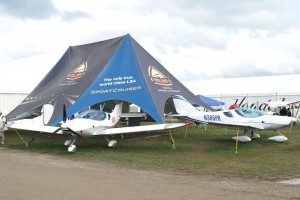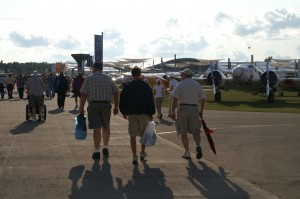GEN Y AND BABY BOOMERS UNITE IN THE SKY: LIGHT SPORT AIRCRAFT
/Gen Y and Baby Boomers Unite in the Sky: Light Sport Aircraft

Thursday at AirVenture 2009 was a wet day. As one person on Twitter noted, "No problem. Rain just makes the airplanes shinier." It also means that the crowds were a touch lighter and the exhibitors had more time to spend with each person. For me this meant talking with them about the growing Light Sport Aircraft market.
Light Sport Aircraft and the Sport Pilot certificate required to fly them are a innovative hope for a shrinking General Aviation market. Frances Fiorino interviewed Experimental Aircraft Assn. (EAA) President Tom Poberezny for the the July 27 issue of Aviation Week & Space Technology (full post here). Their discussion covered many issues, including the ability to keep up the inflow of new pilots. “The enthusiasm is there, the passion is there, but the economy is limiting people’s ability to participate at a level they would like to. It’s not a question of interest or passion, but of economy and time,” says Poberezny." This brings us to the: Light Sport Aircraft/Sport Pilot (LSA/SP) certificate program. Again from Frances Fiorino's article:
The EAA campaigned 10 years for the program, designed to break down the barriers to aviation. The LSA/SP initiative simplified the regulation of manufacturing processes, enabling aircraft makers to build affordable, easy-to-fly aircraft that cut training time. The new category LSAs are one- or two-seat, single-engine, fixed-wing aircraft with a maximum gross weight of 1,320 lb. The aircraft have a stall speed of 45 kt. and fly at a maximum speed of 120 kt. Trainees aiming to secure a sport pilot certificate have limited flying privileges, but they can train in less time and at significantly lower cost—$3,000, compared to an average $8,000-10,000 to train for a private pilot certificate.
It seems we are seeing a market engendered by both Baby Boomers and Gen Y. Baby Boomers in that they may not be able to get or hold on to the stringent medical approval needed for a Private Pilot certificate -- Gen Y in that it costs about half as much to complete the training for a Sport Pilot certificate as it does for the Private Pilot one, something that will also be attractive to Baby Boomers on limited budgets. I saw several three-generation family groupings of aviation enthusiasts -- many in front of the LSA exhibits. 
I'm impressed by the creativity, innovation, and systems savvy shown by the general aviation industry partners: EAA, Aircraft Owner and Pilots Association, aircraft designers and builders, the Federal Aviation Agency, flight schools, etc. They saw a change in the market and have worked together for years to respond in a complex, federally regulated arena. This has required changes in regulations, new training courses, new aircraft designs, and new marketing. From the number of LSAs on display, interest is high. Quoting FAA head J. Randolph “Randy” Babbitt's speech today, "Bottom line: LSA is a healthy industry, and all indications are that it will continue to stay that way." I say, nice innovation.







